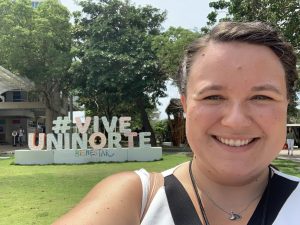My internship took an unexpected turn when, halfway through the summer, the Inter-American Court of Human Rights (IACtHR) announced that its next session of hearings, from August 26th to September 6th, would not take place in San José as planned. Instead, they would be a “special session” or “extraordinary session” in Barranquilla and Bogotá, Colombia.
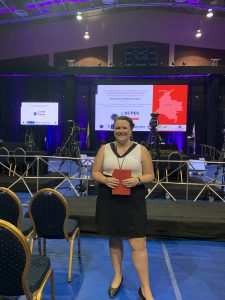
Interns are allowed to attend the extraordinary sessions of the Court, they often don’t because they must undertake all the travel planning and expenses themselves. Coincidentally, I had happened to book a holiday to Colombia to visit family after my internship before the extraordinary session in Colombia was even announced. The dates coincided perfectly, so I decided to take advantage of the chance to see what happens when an international human rights tribunal goes in the field.
The Court holds hearings four times per year on-site in San José (called “ordinary sessions”) but since 2005 it sometimes adds sessions on-location in countries that have ratified the American Convention on Human Rights (these are called “extraordinary” or “special” sessions). You can see the list of past sessions here. Unusually, there weren’t any ordinary sessions scheduled during my internship at the Court. This was why I made the effort to go to Colombia: I wanted to see the Court in action!
The Role of the IACtHR in Guaranteeing Human Rights in the Hemisphere
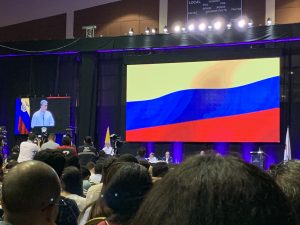
The hearings in Barranquilla were open to the public and held in a university, the Universidad del Norte. The first day, August 26th, consisted of the inauguration ceremony for the special session and a one-day seminar on the role of the Court in guaranteeing human rights in this hemisphere. When I arrived, I noticed that security was tight. There were a lot of police officers and each guest had to present identification. When I got into the auditorium where the sessions would be held, I was very impressed: the room was huge! There must have been 1000 seats and they were all full. I soon found out the reason for the extra-tight security as well. Colombian president Iván Duque had made the trip to Barranquilla to deliver a speech and open the session. Before President Duque, Adolfo Meisel, the Rector of the Universidad del Norte and Eduardo Ferrer Mac-Gregor, the President (Chief Justice) of the Court gave their remarks.
I was really inspired by Justice Ferrer’s remarks, in which he named what he sees as today’s most significant challenges to human rights:
- Persistent poverty, especially considering that Latin America is the most unequal region of the world;
- Discrimination and violence against women, as well as the exclusion of women from decision-making;
- Migration crises (specifically in Venezuela and Central America), where we face a crisis of migration as well as solidarity;
- Climate change and its specific impact on the most vulnerable populations;
- Organized crime and violence which are an increasingly large threat to the region; and
- Authoritarianism, and discourse that aims to restrict rights and freedoms, recognizing that democracy requires a diverse range of views, but cannot exist when certain groups are labelled enemies of the state or when we allow hate speech.
Justice Ferrer also explained the purpose of the Court’s special sessions, of which 30 have taken place in 19 different countries. Colombia is the country who has hosted the largest number of special sessions: 5 in total (two in Bogotá, one in Medellín, one in Cartagena, and now in Barranquilla and Bogotá again). He said the special sessions are important because it facilitates the work of the Court, both by bringing the system closer to the victims of human rights violations (such as when the court holds hearings to monitor a state’s compliance with its previous decisions), but also brings people closer to the system, facilitating a useful dialogue between the Court, governments, and civil society.

In the first panel discussion, a reflection on 40 years of interpretation and application of the American Convention on Human Rights by the Court, Professor Mariela Morales from the Max Planck Institute gave a very interesting overview of the history of the Court and its unique contributions to the development of international human rights law. She mentioned that the Court is unique because it is a “Corte de toga y mochila” (a Court with robes and backpacks), as it travels to member states to hold hearings, echoing the comments of Justice Ferrer. She explained how the Court was born from the aftermath of the wave of military dictatorships in Latin America around the 1970s and 1980s, and how due to this history, one of its first contributions to international human rights law was developing a legal framework on how states must respond to forced disappearances.
Indeed, I noticed a strong thread of public legal education throughout the sessions. A printed program on each seat in the auditorium included the “ABC’s of the Inter-American Court of Human Rights”, a short guide to the structure and purpose of the Court. The whole first day was geared towards people who maybe didn’t have a 100% familiarity with the system, complete with explanations of the purpose and history of the Inter-American Human Rights System. You can see video recordings of all the seminars and public hearings here. As the sessions took place on a university campus, I noticed groups of students wandering in and out of the auditorium to listen to the seminars and hearings between their classes.
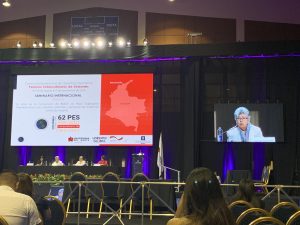
My favourite panel was reflecting on 25 years since the ratification of the Inter-American Convention on the Prevention, Punishment and Eradication of Violence Against Women (also known as the Belem do Pará Convention). It was moderated by Justice Elizabeth Odio Benito, the only woman judge currently sitting on the IACtHR. Justice Odio’s opening remarks touched on how much progress has been made in terms of women’s rights in the past 25 years, but also that we have a long way to go.
The first speaker was Julissa Mantilla, a commissioner-elect of the Inter-American Commission on Human Rights (IACHR). She spoke about the need to develop a further framework to look at the presence and impact of sexual violence specifically as a part of forced disappearance and in truth commissions. She raised 5 important points when it comes to women’s rights in the Americas: 1) we must always use a differentiated analysis consider the specific impact on women in human rights issues; 2) it is important to note the impacts of intergenerational trauma; 3) violence against women is seriously under-reported; 4) the IACHR now has more women than men serving as commissioners, but we still need to make progress in the representation of women as decision-makers; 5) femicide (intentional murder of women) is still a huge problem in society, and in order to tackle it we need to remember that it is not a women’s issue, but rather a human rights issue that is a problem for everyone.
I was also really interested in the talk by María Paulina Riveros Dueñas, who was until recently the Deputy Attorney General of Colombia. She talked about how gender issues were incorporated into the negotiations of Colombia’s historic peace agreement with the Revolutionary Armed Forces of Colombia (FARC), which ended more than 50 years of war in the country (the peace agreement has hit a big bump in the road this week, after Ms. Riveros’s talk). Ms. Riveros that the peace agreement was revolutionary for the way it gave women’s groups and victims’ representatives a seat at the table. She pointed out three significant developments related to gender that came out of the agreement: 1) it underlined the importance of helping victims heal and move beyond the state of being a victim in transitions from war to peace; 2) the Truth Commission created by the agreement has a specific working group charged with completing a gender-differentiated analysis of the conflict; and 3) the agreement created a gender research group as part of Colombia’s Special Jurisdiction for Peace (JEP), which is a special tribunal created to implement transitional justice in Colombia.
Azul Rojas Marín vs. Perú
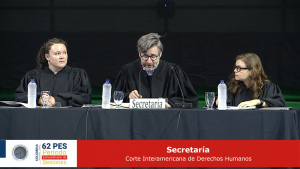
On August 27th I had the chance to help out with the morning and afternoon hearings of the Inter-American Court of Human Rights in the Case Azul Rojas Marín vs. Perú. I was a little more involved in helping out with this particular case as my supervising lawyer was the Court’s point-person on this file. The case is about violence motivated by discrimination against a member of the LGBT community, and also questions how we define torture in international law. The Inter-American Commission on Human Rights (IACHR) considered that Peru had violated its obligation to protect victims of sexual violence, with the aggravating factor of prejudice against members of the LGBT community.
I had learned a lot about the Court and how it functions over the course of my internship, but it was definitely a different experience to see a hearing in person. One thing that really stood out to me was how the Court hearings involve three parties: the State, the victims and their legal representatives, and the Inter-American Commission. It makes a big difference to be in a courtroom with three parties instead of just two, as I am used to seeing in Canada.
If you’re familiar with the procedure of the IACtHR, you know that victims cannot present complaints directly to the Court. Rather, they must first approach the Commission. The Commission will make a determination of whether the State was in violation of its regional obligations and make recommendations. Then, if necessary, it will refer the matter to the Court for a binding ruling.
As such, in hearings of the Court, the Commission is the first of the parties to speak, presenting a summary of the case. Then the victims’ representatives and the State make their oral arguments. Finally, all three parties have the chance to make final statements and respond to the arguments of the other parties. The judges have a chance to ask questions to the lawyers after each party’s allotted time. I didn’t observe judges interrupting lawyers with questions as often happens in Canadian courts: rather, they hold their questions until the end.
A successful innovation
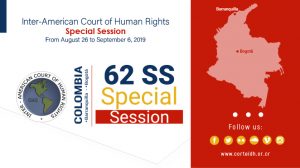
In 2009, Pablo Saavedra, the Court’s registrar, and Gabriela Pacheco, a former lawyer for the Court, wrote that Special Sessions “have been the most innovative and successful initiatives created by the Court” (my translation). The primary benefit they site of these sessions is that they facilitate the work of the Court. On the one hand, they permit the Court to hold more hearings per year and process more cases. On the other hand, they permit the Court to interact with internal state organs of the countries concerned, which fits with the Court’s belief that respect for human rights is primarily an obligation internal to States. Finally, they are accompanies by training and education in human rights for state agents and civil society, as I experienced in Barranquilla, which empower individuals to use the Inter-American Human Rights System.
Overall, I count myself extremely lucky to have had the chance to travel to Colombia to observe what happens when an international human rights tribunal packs up its robes and heads into the field. Having seen the Court in action, I am convinced that its special sessions are an important part of its work, as they bring the Court closer to the communities it serves and give the legal community and the general public the opportunity to learn about the Inter-American Human Rights System. Because of the Special Sessions, it is truly a corte de ciudadanas y ciudadanos (a court of the people).
